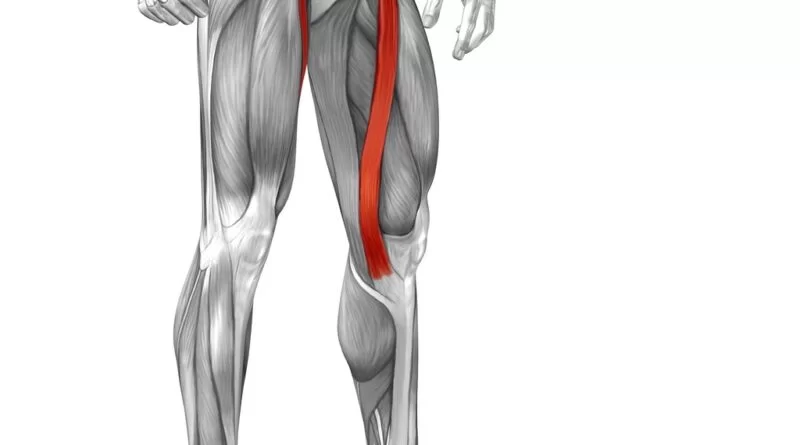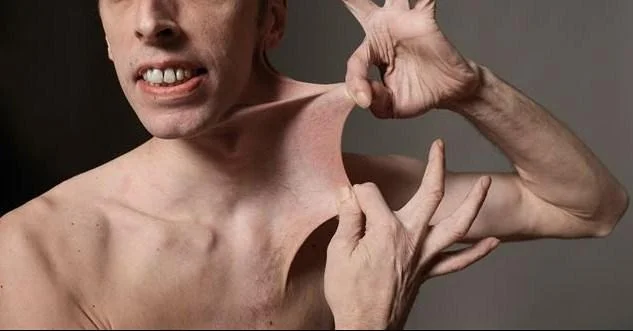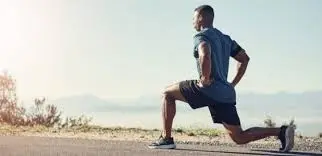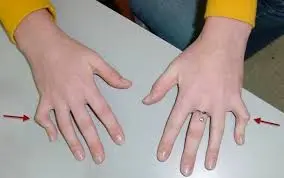Sartorius Muscle Pain
Sartorius muscle pain refers to discomfort or strain in the longest muscle of the human body, which extends diagonally across the front of the thigh from the hip to the inner knee. This muscle is essential for movements such as hip flexion, abduction, external rotation, and knee flexion.
Pain in the sartorius muscle can result from overuse, injury, poor posture, or biomechanical imbalances, often impacting mobility and daily activities. Proper understanding of this condition is key to effective diagnosis and treatment.
What is sartorius muscle pain?
- Because it aids in knee flexion, hip rotation, and joint flexion, this muscle is also referred to as the tailor’s muscle.
- The sartorius muscle is active when the patient sits with one leg folded across the other.
- There are numerous causes of this pain, including muscle strain and tear.
- Additionally, the patient experiences leg weakness.
- The RICE method at home and physical may help to lessen this pain.
Cause of the sartorius muscle pain?
- Overuse of the muscle Sartorius
- The Sartorius muscle is strained.
- occur when the sartorius muscle tears
- Pes anserine tendinitis
- A pinched nerve injury in the lumbar spine causes paresis and paralysis of the Sartorius muscle.
- Because all the muscles cooperate and perform movement, a sartorius muscle injury typically coexists with an injury to another thigh muscle, such as the psoas or quadriceps.
Symptoms of the sartorius pain?
The reason of this muscular soreness determines the symptoms.
Sartorius tendonitis:
- Sartorius muscle Usually, tendinitis causes pain and restricted muscular movement.
- When walking, the patient experiences pain in the front of the hip joint when flexing and rotating the joint.
- Physical therapy aids in improving mobility and reducing muscle inflammation.
Sartorius tear:
- Pain and edema are created in the sartorius muscle when a tear develops.
- For the muscle to heal, a considerable amount of immobility and rest are required.
- Tendonitis of the pes anserine:
- The medial and front aspects of the upper shin bone, directly behind the knee joint, are painful for the patient in this disease.
- Physical therapy improves sartorius strength or flexibility while reducing pain and inflammation.
Weakness due to nerve injury:
- Herniated discs and spinal foraminal stenosis cause nerve compression in the lower back and cause pain and weakness in the front of the thigh by damaging the sartorius muscle.
- Treatment consists of posture correction exercises and nerve compression relief activities.
The Sartorius muscles cause issues with the following movements:
- A running fall.
- A placed foot twisting abruptly.
- When sitting or sleeping, keep your legs up.
- keeping one’s posture twisted.
- Swimming, skating, soccer, and hockey are a few popular sports that are frequently utilized to force hip adduction. This is how the trigger points in this muscle are set up.
How to Diagnose Sartorius muscle pain?
- In order to begin the appropriate treatment of the cause of pain, patients should consult their healthcare professional and obtain an accurate diagnosis if they suspect any of these issues.
- The evaluation is followed by the medical professional in order to diagnose pain.
- In order to determine the reason of the pain, the doctor and physical therapist first take a history.
- The section of the observation looks at the swelling in the painful location.
- Next, palpate the swellings and spasms.
- As part of the evaluation, the hip joint’s range of motion and muscular strength are assessed.
What is the treatment of Sartorius pain?
The RICE principle is the first step in treating muscle pain.
- R-rest = Take a few days off when the patient has muscle soreness.
- I-ice = applied ice to the painful area for 20 minutes; you may also use frozen peas and an ice pack to relieve pain and reduce swelling.
- C-compression: Used to apply a compression bandage to the painful area in order to reduce swelling and pain.
- E-elevation = raised to the leg to lessen swelling with a pillow’s assistance.
Foam Rolling:
- The patient is supporting the knee and elbow joints with weight.
- With the foam roller’s edge touching the inner hip, position it beneath the belly and between the thighs.
- To glide the foam roller along the inner thigh, carefully move the body using the elbow joint and straight leg.This is quite delicate, yet the foam roller makes each pass.
- in order to raise the muscle’s pressure.
- When it is applied like a massage, it releases muscle spasms and edema.
- Three times a day, repeat this foam rolling.
- When someone presses a trigger point, they always experience pain and sensation in another area.
- First, locate the muscle’s trigger point, which is where the most painful spot is.
- Apply pressure to the trigger point and keep it there for at least one minute and no more than two minutes, or until the tissue starts to soften.Then, without moving the finger, gently release this pressure.
Physical Therapy Treatment for Sartorius muscle pain?
Stretching, strengthening exercises, and yoga are all part of the physical therapy treatment, which helps to ease muscle pain.
Stretching Exercise for the Sartorius pain:
This stretching technique aids in easing muscle tension and spasms.
- Kneeling Stretch
- Standing Stretch
Kneeling Stretch:
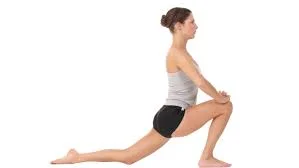
- The patient has one knee on the floor and is kneeling.
- Surely Maintain an upright spine.
- Maintain a neutral pelvic posture.
- Maintaining a straight spine, lean forward.
- keeping the pelvis level while pushing it forward.
- Next, tighten your buttock muscles and feel for the proper movement.
- After 30 seconds of holding the stretching position, slowly release it and repeat the stretching on the opposite side.
- Do this stretching three times in a single session and three times every day.
Standing Stretch:
- As near to the buttocks as you can, bring the left heel.
- Then take both hands and grasp the left foot.
- advancing the hips without bending the back.
- In addition to the front of the hip joint, the patient may also feel a stretch down the inside of the thigh.
- Continue the stretch until each leg has been held for a complete minute.
Strengthening exercise for Sartorius muscle pain:
- Plie Squats
- Clam Exercise
- Step-ups
Plie Squats:
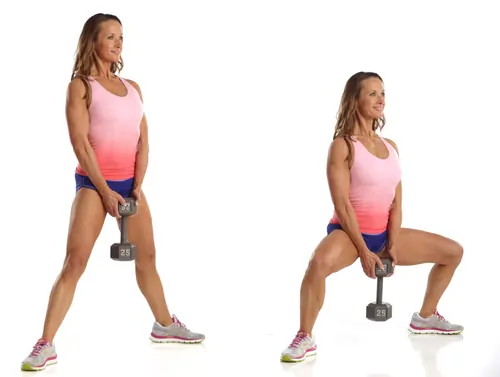
- In order to abduct the hip joint for the Plie Squats, step the feet laterally out from the midline to provide a broad base of support.
- After that, turn the hip joint outward so that the feet, knees, and thighs face the room’s sides.
- To keep the knee joint in line with the toes, bend the knee and hip joint, lowering the glutes muscle straight down while maintaining the hip joint’s external rotation.
- Ten repetitions of this exercise are done in a single session.
- To enhance the resistance, dumbbells and a barbell are also used in this workout.
Clam Exercise:
- In order to support the head and neck, the patient is laying on the side that is affected, with the arm extended upward.
- Ascertain that the body is perpendicular to the floor and that the knee, hip, and shoulder joints are stacked.
- As if the clam were opening up, keep the big toes contacting, tense your core, and externally rotate your hip and knee joints.
- Rotate as much as is comfortable while maintaining proper form, then turn the exercise tool around and internally rotate the hip joint to return to the beginning position.
- Complete ten reps of this exercise, then switch to the other side.
Step-ups:
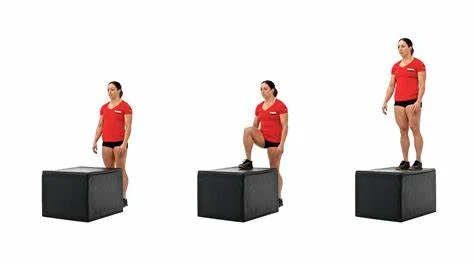
- The standing position is the initial position for the test.
- Step one foot onto a step bench, platform, or the lowest rung of a staircase.
- The patient needs to be maintained at pelvic level.
- To back up the position, lightly touch the toe to the floor and then stand up.
- Do this step-up exercise three times a day and ten times in a single session.
- The sartorius muscle is the primary objective of this step-up exercise, however it works nearly every lower body muscle.
Lateral band walks:
- Above the ankle joint, the patient wraps the band around their legs.
- Next, move the right leg laterally while bending both legs slightly.
- Move the left leg closer and pull the band against the resistance.
- Then proceed in the same manner for at least ten to twelve stages.
What is the yoga pose for Sartorius’s pain?
- Reclining Hero Pose (Supta Virasana)
- Half Reclining Hero Pose (Ardha Supta Virasana)
- Bow Pose (Dhanurasana)
- Camel Pose (Ustrasana)
- Firefly Pose (Tittibhasana)
- High Lunge
- Low Lunge (Anjaneyasana)
- One-Legged King Pigeon Pose
- Tree pose
Reclining Hero Pose:
- Virasana, which involves exhaling and lowering the back torso toward the floor, is performed by the patient first.
- The patient leans first on their hands, then on their elbows and forearms.
- After placing the hand on the elbow joint, place the hands on the back of the pelvis and spread the flesh down toward the tailbone to relax the upper buttocks and lower back.
- Next, insert the thighbone heads well into the rear of the hip joint sockets.
- To ease groin pain, it’s acceptable to raise the knee joint slightly off the ground.
- Additionally, the patient is using a heavily folded blanket to elevate the knee joint a few inches.
Half Reclining Hero Pose:
- To ensure that both sitting bones are flat on the mat, move the patient’s right foot as far to the right as necessary. Verify that the right knee points straight front and that the left foot and toes point straight back.
- The patient lowers their arms to the mat or descends onto their elbows, raises them overhead, and grasps onto the elbow joint on the other side.
- For three to five calm breaths, the patient maintains this position.
- After that, let go of your arms, bring your hands to the mat, and gently press your back up for the opposite side.
Bow pose:
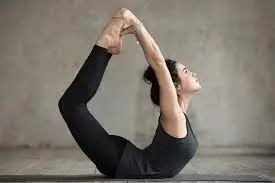
- A blanket is placed beneath the patient’s pelvis as they lie on their tummy on the mat.
- Keep your toes active by pressing all of them into the floor and then bending your knee joint.
- Use your hands to grasp the outside borders of your ankles, then flex your feet firmly.
- Raise your shoulders and rib cage toward your ears as you inhale.
- Lengthen the tailbone and kick the legs back into the hands while they are gripping tightly during the exhale.
- Next, raise the heart and head.
- To raise the chest, apply pressure through the thighs.
- For 30 seconds, the patient maintains the position.
Camel Pose:

- The patient is kneeling with both knees shoulder-width apart on the mat.
- The patient transitions from an arch to a backbend.
- Repeat this yoga stance multiple times after holding it for 30 seconds.
Firefly Pose:
- Begin by bending forward while standing, keeping your knees slightly bent and your toes pointed slightly out.
- Placing the right shoulder behind the right knee, hold the right calf with the right hand through the legs.
- Next, place the right hand, fingers pointing front, on the floor behind the heel.
- On the left side, repeat same stance.
- Lower the legs gently onto the backs of the upper arms while tilting the chest forward.
- The patient has flexed or pointed feet.
- Exhale as you release your feet to the floor after holding this yoga pose for 15 seconds or longer.
High Lunge:
- Adho Mukha Svanasana, or downward-facing dog, is a good place to start.
- In order to position the knee joint over the heel, exhale and place the right foot forward between your palms.
- Maintain a sturdy and powerful left leg.
- The patient inhales and straightens their torso.
- Avoid pushing the front ribs forward.
- Pull them into the torso and down.
- Next, stretch through the small fingers and raise the arms from the lower back ribs.
Low Lunge:

- After lowering the left knee to the floor while maintaining the right knee fixed, slide the left back until the left front thigh and groin feel comfortably stretched.
- Lift the pubic bone toward the navel and pull the tailbone downward toward the floor.
- Raise the chest by pressing the shoulder blades firmly on the rear of the torso.
- Be cautious not to jam the back of the neck as you take the head back and look up.
- Hold for a minute, then release the breath and return the hands to the floor and the torso to the right thigh before turning to the back toes under.
One-Legged King Pigeon Pose:
- In order to position the left foot in front of the right knee and the outside of the left shin resting on the floor, begin on your hands and knees.
- Outside the line of the hip joint, the left knee is angled slightly to the left.
- Examine the right leg from behind. From the hip joint, it stretches the straight back.
- Raise your torso off your thigh.
- Press the tailbone forward and down to lengthen the lower back.
- Point the right front hip toward the left heel, a little forward.
- Hold the pose for a few breaths, then release each hand individually and drop your torso over your left leg and onto the floor.
- The patient repeats with the opposite side after being held for a few breaths.
Tree pose:
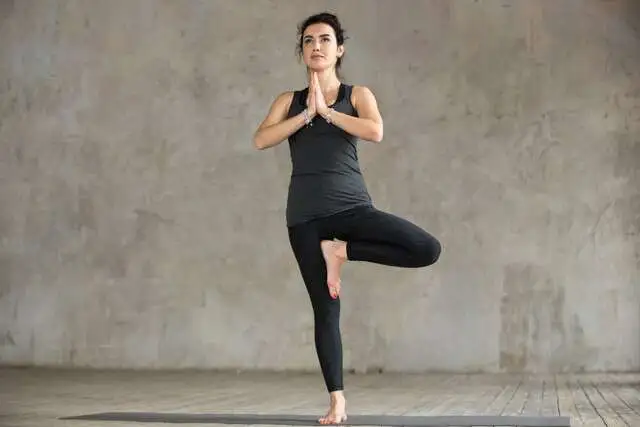
- The Vrksasana is another name for this yoga position.
- By spreading their toes, pressing their feet into the mat, and strengthening their leg muscles, the patient is standing in the Tadasana position.
- Next, lift the front hip points in the direction of the lower ribs, which are subtly raised in the lower abdomen.
- Inhaling deeply, the patient raises their chest and exhales as they pull their shoulder blades down their back.
- The patient’s gaze is fixed forward.
- Refrain from touching the knee joint.
- Press the left leg and right foot together.
How to prevent Sartorius muscle pain?
- Avoid uncomfortable activities and use gentle stretching techniques until the injured limb regains its full range of motion and normal strength.
- The patient warms up and cools down during the activity to prevent sartorius muscle soreness.
- Maintain proper body mechanics at all times and perform the appropriate inner thigh strength training and stretching activities, which are crucial parts of the therapy regimen.
FAQs
Can pain in your knees result from sartorius?
An individual may acquire this condition if overuse or injury irritates the bursa beneath the tendons of the sartorius, gracilis, and semitendinosus. Chronic knee weakness and pain are often caused by this ailment, which typically affects athletes who misuse their knees.
What are the sartorius trigger points?
Sartorius trigger points can cause leg cramps, difficulty climbing stairs, and meralgia paresthetica, which is numbness and tingling in the outer thigh. They can also refer pain along the muscle from the front of the hip and thigh down through the medial thigh and to the medial knee.
Does the sartorius muscle get used during squats?
Standard squats and lunges, lateral step-ups, lateral band walks, plié squats, and clamshell movements are all good ways to strengthen the sartorius.
How are sartorius techniques massaged?
It’s easy to massage the Sartorius. With the injured leg’s knee on the floor and the other leg pointed up at the sky, take a seat on the floor. Press on the trigger point with your opposing elbow.
How can sartorius pain be eliminated?
Pain and swelling from a strained sartorius muscle can be reduced by rest, ice therapy, compression, and elevation. Stretching and strengthening activities might help with rehabilitation after the acute pain has subsided.
Does the sartorius muscle benefit from walking?
The sartorius is actually worked every time you perform a lunge or squat, as well as every time you jog or walk.
What gives the sartorius muscle its name, honeymoon muscle?
Because Sartorius’s muscle is located in the inner thigh, which is regarded as an erogenous zone, it is also known as the honeymoon muscle. The female partner’s vagina is exposed when the sartorius muscle abducts and laterally rotates the thigh.
What is the sensation of sartorius pain?
Some people have a scorching, aching feeling along the inside of their knee when they have sartorius pain. The pes anserine bursa, which are tiny, fluid-filled sacs that cushion the tissues close to the knee joint, may have become irritated as a result.
References
- Ladva, V. (2024f, December 30). Sartorius muscle pain: Cause, symptoms, Treatment, Exercise – Samarpan. Samarpan Physiotherapy Clinic. https://samarpanphysioclinic.com/sartorius-muscle-pain/#google_vignette
- Weber, B. (2023, January 18). What to know about sartorius muscle pain. https://www.medicalnewstoday.com/articles/sartorius-muscle-pain

